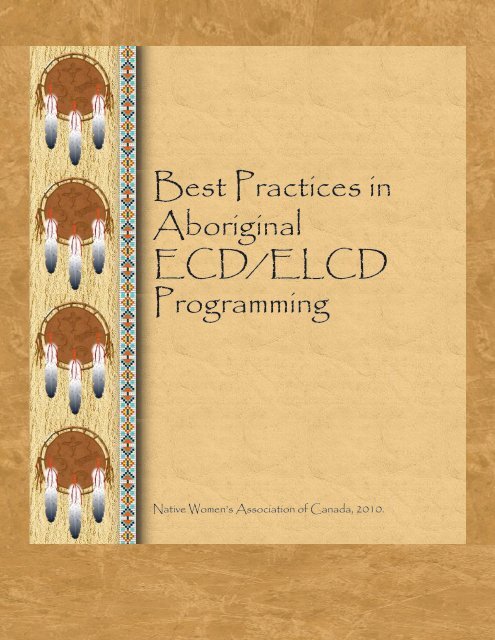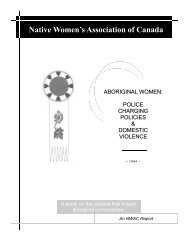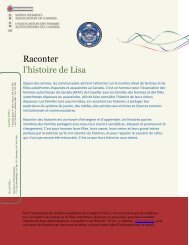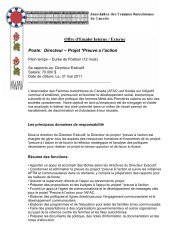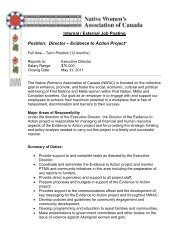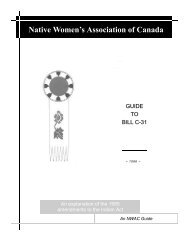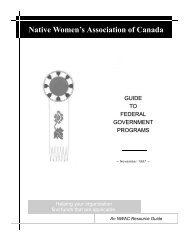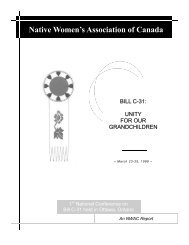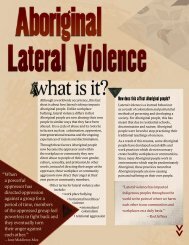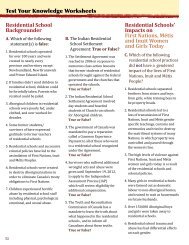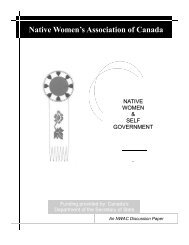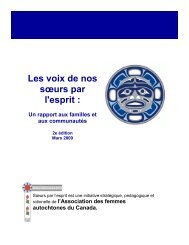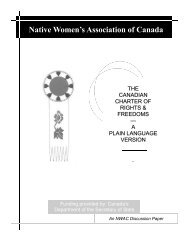Best Practices in Aboriginal ECD/ELCD Programming - Native ...
Best Practices in Aboriginal ECD/ELCD Programming - Native ...
Best Practices in Aboriginal ECD/ELCD Programming - Native ...
You also want an ePaper? Increase the reach of your titles
YUMPU automatically turns print PDFs into web optimized ePapers that Google loves.
<strong>Best</strong> <strong>Practices</strong> <strong>in</strong><br />
Aborig<strong>in</strong>al<br />
<strong>ECD</strong>/<strong>ELCD</strong><br />
Programm<strong>in</strong>g<br />
<strong>Native</strong> Women’s Association of Canada, 2010.<br />
1
<strong>Best</strong> <strong>Practices</strong> <strong>in</strong> Aborig<strong>in</strong>al<br />
<strong>ECD</strong>/<strong>ELCD</strong> Programm<strong>in</strong>g<br />
Inf<strong>in</strong>ity Consult<strong>in</strong>g, a solely owned Métis company directed by Dr. Carrie Bourassa<br />
(Reg<strong>in</strong>a, SK), was contracted to develop a booklet outl<strong>in</strong><strong>in</strong>g best practices <strong>in</strong> Aborig<strong>in</strong>al<br />
<strong>ECD</strong>/<strong>ELCD</strong> Programm<strong>in</strong>g. Dr. Bourassa contracted Calv<strong>in</strong> Racette, Sarah<br />
Longman and Dr. Shauneen Pete (all from Reg<strong>in</strong>a, SK). The study was also aided<br />
by a research assistant Chelsea Millman.<br />
<strong>Native</strong> Women’s Association of Canada, 2010<br />
www.nwac.ca<br />
2
Background<br />
This booklet was based on a March 2009 report <strong>in</strong> that provided an overview of<br />
<strong>ECD</strong>/<strong>ELCD</strong> literature and best practices <strong>in</strong> Canada (NWAC, 2009). The literature<br />
review outl<strong>in</strong>ed specific best practices <strong>in</strong> relation to early learn<strong>in</strong>g. Themes which<br />
emerged <strong>in</strong> that study <strong>in</strong>cluded: traditional values; support<strong>in</strong>g the development of<br />
the whole child, education and school read<strong>in</strong>ess, health promotion and nutrition,<br />
Social support, and parental and community <strong>in</strong>volvement. The literature review<br />
formed the foundation for develop<strong>in</strong>g the next phase of the overall study.<br />
The next step was to identify a small sample of organizations that reflected Aborig<strong>in</strong>al<br />
organizations across Canada deliver<strong>in</strong>g Aborig<strong>in</strong>al Early Childhood Development<br />
and/or Early Learn<strong>in</strong>g Childhood Development programs (off-reserve).<br />
This was followed by an undertak<strong>in</strong>g of surveys with the objective to gather site<br />
<strong>in</strong>formation as to what they perceived to be their best practices and to identify the<br />
strengths of their programs. The <strong>in</strong>tent of the survey was to collate the <strong>in</strong>formation<br />
and share this at a national level with Aborig<strong>in</strong>al Head Start programs and Friendship<br />
Centers across Canada.<br />
3
Survey Tool Development<br />
The literature review provided a foundation for determ<strong>in</strong><strong>in</strong>g the questions for the survey<br />
<strong>in</strong>strument design. The research team created three separate questionnaires for use with<br />
the directors, staff, and parents at selected early learn<strong>in</strong>g centers across Canada.<br />
Further, the survey was made available <strong>in</strong> both the English and French languages. The<br />
on-l<strong>in</strong>e tool <strong>in</strong>corporated the use of Survey Monkey (onl<strong>in</strong>e survey builder) to design the<br />
survey and collect the data<br />
The survey took approximately 20 m<strong>in</strong>utes to complete, comments and survey responses<br />
were comb<strong>in</strong>ed with all responses so that <strong>in</strong>dividuals or organizations responses cannot<br />
be attributed to any specific site.<br />
The study was not designed to be comprehensive but rather was <strong>in</strong>tended to provide a<br />
snapshot of responses from a representative sampl<strong>in</strong>g of the <strong>ECD</strong>/<strong>ECD</strong>L programs.<br />
Response Rates<br />
The aim was to engage twenty early learn<strong>in</strong>g centers <strong>in</strong> the survey process. The team<br />
identified programs through <strong>in</strong>formation provided by the National Head Start website<br />
from each prov<strong>in</strong>ce and territory.<br />
“The community is becom<strong>in</strong>g very aware of<br />
Aborig<strong>in</strong>al culture and is facilitat<strong>in</strong>g cultural<br />
activities on their own.”<br />
- Respondent<br />
4
Results of the Surveys<br />
Although the target was 20 responses from centers across Canada, only 8 were obta<strong>in</strong>ed.<br />
Despite this, very <strong>in</strong>terest<strong>in</strong>g <strong>in</strong>formation was revealed from the survey results:<br />
1. Most centers operate on Federal fund<strong>in</strong>g.<br />
2. Employees are considered long-term (directors were employed for 7.8 yrs and staff<br />
for 5.7 yrs.).<br />
3. Centers operated 10 months out of the year and served children between 4 and 5 yrs<br />
old.<br />
4. Centers serve primarily First Nations communities (66.7%) and secondly Métis communities<br />
(33.3%); one centre served primarily Inuit families.<br />
5. Most centers <strong>in</strong>dicated there was a wait<strong>in</strong>g list.<br />
6. Directors reported it was important to improve parent/caregiver skills and <strong>in</strong>clusion <strong>in</strong><br />
the program and social network<strong>in</strong>g.<br />
7. Important to improve parental access to resources, knowledge, skills and competencies.<br />
8. Community engagement and awareness was important.<br />
9. Culture, education and pride <strong>in</strong> the child’s identity is extremely important.<br />
10. A majority of centers have cross-cultural awareness Tra<strong>in</strong><strong>in</strong>g.<br />
11. Centers often act as advocates for parents.<br />
12. Education and school read<strong>in</strong>ess; traditional values; development of the whole child;<br />
health promotion; social supports and parental and community <strong>in</strong>volvement appear to<br />
be key elements to all the programs at the centers who responded to the survey.<br />
“We have a culture and language component<br />
to our program. Everyth<strong>in</strong>g we do here has<br />
the Ojibwa language woven <strong>in</strong>to it - visuals on<br />
the walls, staff speak<strong>in</strong>g to children, culturally<br />
appropriate toys.”<br />
- Respondent<br />
5
<strong>Best</strong> <strong>Practices</strong> – An Overview<br />
In early 2009 Inf<strong>in</strong>ity Consult<strong>in</strong>g undertook an extensive literature review that revealed<br />
best practices <strong>in</strong> Aborig<strong>in</strong>al <strong>ECD</strong>/<strong>ELCD</strong> Programm<strong>in</strong>g.<br />
Based on analysis of the literature, 6 key themes emerged:<br />
• Traditional Values<br />
• Education and School Read<strong>in</strong>ess<br />
• Development of the Whole Child<br />
• Health Promotion<br />
• Social Supports<br />
• Parental and Community Involvement<br />
One particularly excellent resource that all <strong>ECD</strong>/<strong>ELCD</strong> programs can benefit from is the<br />
Handbook of <strong>Best</strong> <strong>Practices</strong> <strong>in</strong> Aborig<strong>in</strong>al Early Childhood Programs published <strong>in</strong> 2003<br />
by BC Aborig<strong>in</strong>al Child Care Society.<br />
The handbook outl<strong>in</strong>ed 6 key areas that culm<strong>in</strong>ated <strong>in</strong> best practices:<br />
• Traditional Values<br />
• Community Involvement<br />
• Network<strong>in</strong>g<br />
• Policies and Procedures<br />
• Assessment<br />
• Evaluation<br />
Based on the analysis of the literature and the handbook, best practices that can be implemented<br />
by any Aborig<strong>in</strong>al <strong>ECD</strong>/<strong>ELCD</strong> program should conta<strong>in</strong> the follow<strong>in</strong>g elements:<br />
Traditional Values<br />
Incorporate cultural knowledge of the community <strong>in</strong>to philosophy and curriculum of the<br />
centre.<br />
Include cultural protocols and teach<strong>in</strong>gs <strong>in</strong>to activities; establish a community garden;<br />
<strong>in</strong>clude Elders and community members <strong>in</strong>to daily activities;<br />
6
Hold community based celebrations that emphasize cultural knowledge, such as feasts,<br />
round dances, potlatches, pow wows; Incorporate traditional foods and the preparation of<br />
them <strong>in</strong>to the program whenever possible;<br />
Incorporate language as an immersion based program at the school or centre <strong>in</strong>corporat<strong>in</strong>g<br />
Elders as language <strong>in</strong>structors; create a language nest which is a place where members<br />
of the community can come and converse <strong>in</strong> their native language.<br />
Ensure that staff members are culturally competent and that they are members of the<br />
community; staff tra<strong>in</strong><strong>in</strong>g needs to be offered <strong>in</strong> the area of language acquisition and<br />
teach<strong>in</strong>g; A curriculum that is environmental based can be used to assist <strong>in</strong> the transmission<br />
of traditional knowledge; Support culture camps lead by Elders.<br />
Celebrate National Aborig<strong>in</strong>al Day and other key Aborig<strong>in</strong>al celebrations.<br />
Community Involvement<br />
Provide transportation support to community members whenever possible.<br />
Include, develop and teach traditional games and activities; <strong>in</strong>clude families <strong>in</strong> the plann<strong>in</strong>g<br />
of the activities and services; services should enhance community development and<br />
not create dependency.<br />
Coord<strong>in</strong>ate with public and private agencies to maximize services.<br />
Hold parent gather<strong>in</strong>gs and organize staff/parent luncheons or suppers; have a parent’s<br />
advisory council and have parents on your board.<br />
Involve community leaders <strong>in</strong>to the programm<strong>in</strong>g and boards.<br />
Host events that are recognitions of accomplishments, birthdays of children, etc. and <strong>in</strong>clude<br />
traditional recognition methods; Support community based tra<strong>in</strong><strong>in</strong>g and events and<br />
perhaps your agency can provide some assistance with child care.<br />
Have older children work with younger children and have them create community stories<br />
and publish them for use <strong>in</strong> the centre.<br />
7
Network<strong>in</strong>g<br />
A resource list can be developed that identifies recognized community based resource<br />
people that can be accessed to deliver quality cultural programm<strong>in</strong>g.<br />
A resource centre of books and activities that promote traditional stories, community<br />
values and community history could be developed.<br />
Create a resource bibliography of relevant teach<strong>in</strong>g resources; Contact Aborig<strong>in</strong>al publish<strong>in</strong>g<br />
agencies for relevant literature donations and possible field test sites.<br />
Policies and Procedures<br />
Support services and flexible schedul<strong>in</strong>g that will allow young parents to enhance and<br />
pursue their own personal education goals.<br />
Partner and align your program with established fund<strong>in</strong>g organizations. Evolve your budget<br />
cycles and program criteria to fit <strong>in</strong> with their mandates;<br />
Involve the parents <strong>in</strong> the orig<strong>in</strong>al development of your policies and procedures; <strong>in</strong>volve<br />
the parents and Community leaders <strong>in</strong> updates and revisions of your policies and procedures;<br />
Ensure that political <strong>in</strong>terfere is not present on front l<strong>in</strong>e programm<strong>in</strong>g.<br />
Involve the staff with the policies and procedures and ensure that they are relevant and<br />
meet the needs of your program;<br />
Ensure that there is a process to mak<strong>in</strong>g new parents to the program aware of the policies<br />
and procedures.<br />
Develop and enforce a code of ethics for staff and board members that reflects values of<br />
the program and guide decision mak<strong>in</strong>g processes.<br />
Ensure that all new employees undergo reference checks and Crim<strong>in</strong>al record checks to<br />
protect the organization.<br />
Hold staff lunches or retreats for team build<strong>in</strong>g purposes.<br />
8
Create opportunities for even<strong>in</strong>g tra<strong>in</strong><strong>in</strong>g sessions for staff and community members that<br />
enhance cultural identity and Aborig<strong>in</strong>al ways of know<strong>in</strong>g.<br />
Create flexible hours whenever possible; allow for staff to leave early if they work<br />
through breaks.<br />
Use substitute or part time staff whenever possible to avoid burn out and stress related<br />
issues; ensure that staff are allowed to take their annual vacation and at a time when they<br />
can be with their family.<br />
Post the centre rules <strong>in</strong> prom<strong>in</strong>ent areas and make them appeal<strong>in</strong>g; use positive re<strong>in</strong>forcement<br />
strategies with staff and students alike.<br />
Support <strong>in</strong>-service tra<strong>in</strong><strong>in</strong>g, especially courses that are directly related skill development.<br />
Focus on restitution and community well-be<strong>in</strong>g as opposed to punishment; encourage the<br />
use of traditional values such as hugg<strong>in</strong>g and encouragement.<br />
Have a quiet room for time out or m<strong>in</strong>or illnesses; ensure that there is a process <strong>in</strong> place<br />
to deal with serious illness and parental pickup. Ensure that there is a policy on pickup<br />
requirements and who can pick up the students. Ensure that safety procedures on <strong>in</strong> place<br />
for pick up vehicles, i.e., Car seats or booster seats. Ensure that there are clearly def<strong>in</strong>ed<br />
pick up times. Ma<strong>in</strong>ta<strong>in</strong> consistent hours of operation.<br />
Ensure that legal custody arrangements are observed.<br />
Foster a holistic approach and <strong>in</strong>corporate traditional teach<strong>in</strong>g methods <strong>in</strong>to the program.<br />
Ensure that all toys and equipment are regularly cleaned and sanitized.<br />
Assessment<br />
It is of value to teach whenever possible, the differences between western knowledge and<br />
traditional knowledge. In that way, students can learn to walk <strong>in</strong> both worlds.<br />
Include traditional knowledge and values <strong>in</strong>to assessment tools to evaluate cultural competence;<br />
Assign staff to specific students to ensure good home/school communication.<br />
Record out of character situations <strong>in</strong> a log book and be prepared to discuss them with<br />
parents.<br />
9
Evaluation<br />
Have staff do daily and weekly evaluations to assess program effectiveness:<br />
Do student assessment at the beg<strong>in</strong>n<strong>in</strong>g and end of year to gauge learn<strong>in</strong>g.<br />
Include parents and board members <strong>in</strong> the evaluation process; <strong>in</strong>clude staff and students<br />
<strong>in</strong> the evaluation process; consult and <strong>in</strong>clude Elders <strong>in</strong> the evaluation, if possible.<br />
Include outside professional agencies <strong>in</strong>to the evaluation if they work with your centre<br />
(nurses, dentists, police officers, or firemen).<br />
Do quarterly assessments <strong>in</strong> house to allow for changes; do an annual evaluation, us<strong>in</strong>g<br />
an outside source to ensure objectivity.<br />
Create checklists and developmental screens to assist <strong>in</strong> the assessment and determ<strong>in</strong><strong>in</strong>g<br />
of growth; use a wide variety of assessment tools; use assessment tools that are recognized<br />
by <strong>in</strong>dustry standards.<br />
Invite other professionals that <strong>in</strong>teract with your students for assessment <strong>in</strong>put; <strong>in</strong>volve<br />
parents and Elders <strong>in</strong> assessments.<br />
Develop personal profiles of each student and use it as discussion tool with parents.<br />
Ensure that there is opportunity for diversity tra<strong>in</strong><strong>in</strong>g for your staff and <strong>in</strong>clude community<br />
members, if possible.<br />
Evaluations should be driven by goals and must<br />
focus on the program, not staff<strong>in</strong>g.<br />
10
Additional Elements of <strong>Best</strong> Practice<br />
In addition to these elements, four other common themes are helpful <strong>in</strong> strengthen<strong>in</strong>g an<br />
Aborig<strong>in</strong>al <strong>ECD</strong>/<strong>ELCD</strong> program:<br />
• Development of the Whole Child<br />
• Health Promotion<br />
• Education and School Read<strong>in</strong>ess<br />
• Social Supports and<br />
• Parental Community Involvement<br />
The literature and survey results revealed that a holistic approach that encompasses a<br />
medic<strong>in</strong>e wheel model that addresses the physical, mental, emotional and spiritual aspects<br />
of development are extremely important.<br />
Recommendations<br />
While the best practices outl<strong>in</strong>ed <strong>in</strong> this document are be<strong>in</strong>g addressed by many Aborig<strong>in</strong>al<br />
<strong>ECD</strong>/<strong>ELCD</strong> programs across Canada <strong>in</strong> some measure, it is difficult for all programs<br />
and centers to adequately address all of the areas identified as best practices. This is<br />
primarily because of under-fund<strong>in</strong>g, lack of capacity and pressure on exist<strong>in</strong>g staff.<br />
It became clear <strong>in</strong> both the literature review and surveys of Aborig<strong>in</strong>al <strong>ECD</strong>/<strong>ELCD</strong> programs<br />
that many centers are overwhelmed and often operate <strong>in</strong> isolation. As a result, it<br />
is recommended NWAC take the lead <strong>in</strong> develop<strong>in</strong>g a network for all Aborig<strong>in</strong>al <strong>ECD</strong>/<br />
<strong>ELCD</strong> programs <strong>in</strong> Canada.<br />
This can be achieved by:<br />
• Host<strong>in</strong>g a national network<strong>in</strong>g session that profiles “best practices” by Aborig<strong>in</strong>al<br />
<strong>ECD</strong>/<strong>ELCD</strong> centers. The session should focus not only on <strong>in</strong>formation shar<strong>in</strong>g but<br />
help Aborig<strong>in</strong>al <strong>ECD</strong>/<strong>ELCD</strong> centers to document and share their best practices.<br />
• Host a website that can be accessed by Aborig<strong>in</strong>al <strong>ECD</strong>/<strong>ELCD</strong> centers so that centers<br />
can share <strong>in</strong>formation and cont<strong>in</strong>ue the network<strong>in</strong>g with other centers. The website<br />
can also <strong>in</strong>clude updated contact <strong>in</strong>formation for all centers which was found to be<br />
dated dur<strong>in</strong>g the survey process.<br />
• Distribute quarterly newsletters to all Aborig<strong>in</strong>al <strong>ECD</strong>/<strong>ELCD</strong> centers with updates,<br />
news and helpful <strong>in</strong>formation.<br />
11
Based on the analysis of the literature and the<br />
handbook, best practices that can be implemented<br />
by any Aborig<strong>in</strong>al <strong>ECD</strong>/<strong>ELCD</strong> program<br />
should conta<strong>in</strong> the follow<strong>in</strong>g elements:<br />
• Traditional Values<br />
• Community Involvement<br />
• Network<strong>in</strong>g<br />
• Policies and Procedures<br />
• Assessment<br />
• Evaluation<br />
Thank You!<br />
Inf<strong>in</strong>ity Consult<strong>in</strong>g would like to thank all of those agencies who took the time to<br />
complete the surveys. We truly value your time and appreciated your time and<br />
expertise. We would also like to recognize the hard work of all Aborig<strong>in</strong>al <strong>ECD</strong>/<br />
<strong>ELCD</strong> centers across Canada for the extremely important work you undertake day<br />
<strong>in</strong> and day out. We hope this booklet of best practices will assist you <strong>in</strong> the work<br />
you do and help you to start document<strong>in</strong>g your best practices so that others can<br />
learn from your success. We know there are far more successes to celebrate and<br />
we need your help to document and share them with others.<br />
12


